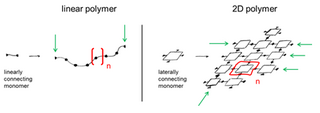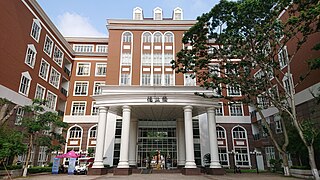In organic chemistry, the Ugi reaction is a multi-component reaction involving a ketone or aldehyde, an amine, an isocyanide and a carboxylic acid to form a bis-amide. The reaction is named after Ivar Karl Ugi, who first reported this reaction in 1959.
Dynamic covalent chemistry (DCvC) is a synthetic strategy employed by chemists to make complex molecular and supramolecular assemblies from discrete molecular building blocks. DCvC has allowed access to complex assemblies such as covalent organic frameworks, molecular knots, polymers, and novel macrocycles. Not to be confused with dynamic combinatorial chemistry, DCvC concerns only covalent bonding interactions. As such, it only encompasses a subset of supramolecular chemistries.

Metal–organic frameworks (MOFs) are a class of porous polymers consisting of metal clusters coordinated to organic ligands to form one-, two- or three-dimensional structures. The organic ligands included are sometimes referred to as "struts" or "linkers", one example being 1,4-benzenedicarboxylic acid (BDC).
Jonathan Paul Clayden is a Professor of organic chemistry at the University of Bristol.

Omar M. Yaghi is the James and Neeltje Tretter Chair Professor of Chemistry at the University of California, Berkeley, an affiliate scientist at Lawrence Berkeley National Laboratory, the Founding Director of the Berkeley Global Science Institute, and an elected member of the US National Academy of Sciences as well as the German National Academy of Sciences Leopoldina.
Asymmetric hydrogenation is a chemical reaction that adds two atoms of hydrogen to a target (substrate) molecule with three-dimensional spatial selectivity. Critically, this selectivity does not come from the target molecule itself, but from other reagents or catalysts present in the reaction. This allows spatial information to transfer from one molecule to the target, forming the product as a single enantiomer. The chiral information is most commonly contained in a catalyst and, in this case, the information in a single molecule of catalyst may be transferred to many substrate molecules, amplifying the amount of chiral information present. Similar processes occur in nature, where a chiral molecule like an enzyme can catalyse the introduction of a chiral centre to give a product as a single enantiomer, such as amino acids, that a cell needs to function. By imitating this process, chemists can generate many novel synthetic molecules that interact with biological systems in specific ways, leading to new pharmaceutical agents and agrochemicals. The importance of asymmetric hydrogenation in both academia and industry contributed to two of its pioneers — William Standish Knowles and Ryōji Noyori — being collectively awarded one half of the 2001 Nobel Prize in Chemistry.
Covalent organic frameworks (COFs) are a class of porous polymers that form two- or three-dimensional structures through reactions between organic precursors resulting in strong, covalent bonds to afford porous, stable, and crystalline materials. COFs emerged as a field from the overarching domain of organic materials as researchers optimized both synthetic control and precursor selection. These improvements to coordination chemistry enabled non-porous and amorphous organic materials such as organic polymers to advance into the construction of porous, crystalline materials with rigid structures that granted exceptional material stability in a wide range of solvents and conditions. Through the development of reticular chemistry, precise synthetic control was achieved and resulted in ordered, nano-porous structures with highly preferential structural orientation and properties which could be synergistically enhanced and amplified. With judicious selection of COF secondary building units (SBUs), or precursors, the final structure could be predetermined, and modified with exceptional control enabling fine-tuning of emergent properties. This level of control facilitates the COF material to be designed, synthesized, and utilized in various applications, many times with metrics on scale or surpassing that of the current state-of-the-art approaches.
The Dreyfus Prize in the Chemical Sciences is an award given to an individual researcher in chemistry. The prize, awarded biennially, consists of a citation, a medal, and a monetary award of $250,000. The prize is awarded by The Camille and Henry Dreyfus Foundation, Inc. to an individual in a selected area of chemistry "to recognize exceptional and original research that has advanced the field in a major way."

A two-dimensional polymer (2DP) is a sheet-like monomolecular macromolecule consisting of laterally connected repeat units with end groups along all edges. This recent definition of 2DP is based on Hermann Staudinger's polymer concept from the 1920s. According to this, covalent long chain molecules ("Makromoleküle") do exist and are composed of a sequence of linearly connected repeat units and end groups at both termini.

Harry Laurence Anderson is a British chemist in the Department of Chemistry, University of Oxford. He is well known for his contributions in the syntheses of supramolecular systems, exploration of the extraordinary physical properties of large pi-conjugated systems, and synthesis of cyclo[18]carbon. He is a Professor of Chemistry at Keble College, Oxford.
Proline organocatalysis is the use of proline as an organocatalyst in organic chemistry. This theme is often considered the starting point for the area of organocatalysis, even though early discoveries went unappreciated. Modifications, such as MacMillan’s catalyst and Jorgensen's catalysts, proceed with excellent stereocontrol.

Hong-Cai (Joe) Zhou is a Chinese–American chemist and academic. He is the Davidson Professor of Science and Robert A. Welch Chair in Chemistry at Texas A&M University. He is the associate editor of the journal Inorganic Chemistry.
Corinna S. Schindler is a Professor of Chemistry at the University of Michigan. She develops catalytic reactions with environmentally benign metals such as iron, towards the synthesis of biologically active small molecules. For her research in the development of new catalysts, Schindler has been honored with several early-career researcher awards including the David and Lucile Packard Foundation Fellowship in 2016, the Alfred P. Sloan Fellowship in 2017, and being named a member of the C&EN Talented 12 in 2017. Schindler has served on the Editorial Board of Organic and Bimolecular Chemistry since 2018.

Mircea Dincă is a Romanian-American inorganic chemist. He is a Professor of Chemistry and W. M. Keck Professor of Energy at the Massachusetts Institute of Technology (MIT). At MIT, Dincă leads a research group that focuses on the synthesis of functional metal-organic frameworks (MOFs), which possess conductive, catalytic, and other material-favorable properties.
Bettina Valeska Lotsch is a German chemist. She is Director at the Max Planck Institute for Solid State Research in Stuttgart, Germany.
Tomislav Friščić holds the Leverhulme International Professorship and Chair in Green and Sustainable chemistry at the University of Birmingham. His research focus is at the interface of green chemistry and materials science, developing solvent-free chemistry and mechanochemistry for the cleaner, efficient synthesis of molecules and materials, including organic solids such as pharmaceutical cocrystals, coordination polymers and Metal-Organic Frameworks (MOFs), and a wide range of organic targets such as active pharmaceutical ingredients. He is a Fellow of the Royal Society of Chemistry (RSC), member of the College of New Scholars, Artists and Scientists of the Royal Society of Canada and a corresponding member of the Croatian Academy of Sciences and Arts. He has served on the Editorial Board of CrystEngComm, the Early Career Board of the ACS journal ACS Sustainable Chemistry & Engineering, and was an Associate Editor for the journal Molecular Crystals & Liquid Crystals as well as for the journal Synthesis. He was a Topic Editor and Social Media Editor, and is currently a member of the Editorial Advisory Board of the journal Crystal Growth & Design published by the American Chemical Society (ACS). He famously has a dog named Zizi.

The Hoffmann Institute of Advanced Materials (HIAM) is a science research institute affiliated to Shenzhen Polytechnic in Shenzhen, China. As the eighth institute at Shenzhen named after a Nobel laureate, it was founded in February 2018 under the tutelage of the theoretical chemist Roald Hoffmann. The institute was officially opened with a formal ceremony in May 2019.

Deanna Michelle D'Alessandro is an Australian chemist who is a Professor and Australian Research Council Future Fellow at the University of Sydney. Her research considers fundamental aspects of electron transfer in molecular coordination complexes and in nanoporous materials, and the development of metal–organic frameworks for environmental applications including carbon dioxide capture and conversion.

Conductive metal−organic frameworks are a class of metal–organic frameworks with intrinsic ability of electronic conduction. Metal ions and organic linker self-assemble to form a framework which can be 1D/2D/3D in connectivity. The first conductive MOF, Cu[Cu(2,3-pyrazinedithiol)2] was described in 2009 and exhibited electrical conductivity of 6 × 10−4 S cm−1 at 300 K.

Jieping Zhu is an organic chemist specializing in natural product total synthesis and organometallics. He is a professor of chemistry at EPFL and the head of the Laboratory of Synthesis and Natural Products.










